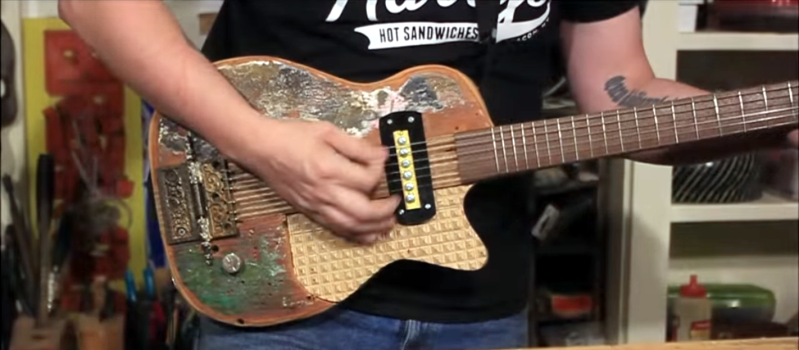[Keith Decent] recently got himself involved in a plywood challenge, and decided to make a single-pickup electric guitar. Since he is a prolific hoarder of scrap wood, the result is a lovely stack of laminates from many sources, including reclaimed cabinet doors. Really though, the wood is just the beginning—nearly every piece of this texture-rich axe started life as something else.
He’s made a cigar box guitar before, but never a bona fide solid-body electric. As you might guess, he learned quite a bit in the process. [Keith] opted for a neck-through design instead of bolting one on and using a truss rod. The face pieces are cut from his old bench top, which has a unique topology thanks to several years of paint, glue, and other character-building ingredients.
We love the geometric inlay [Keith] made for the pick guard, and the fact that he used an offcut from the process as a floating bridge. He also made his own pickup from bolts, an old folding rule, and reclaimed magnet wire from discarded wall wart transformers. Once he routed out the body and installed the electronics, [Keith] cut up an old painting he’d done on plywood to use as the back panel. Our only complaint about this beautiful guitar is that he didn’t design the back piece to be dinosaur side out. Shred past the break to give her a listen.
[Keith] wound his pickup with a little help from a drill, but a DIY pickup winder might have caused him less grief.
















I like it except for the shellac finish. As much as I like shellac as a finish, ethanol is the solvent for it. There is a reason one of my amps prominently listed as a feature that alcohol will NOT harm the finish (it is nitro, not shellac)
yeah I was on a deadline, I’ll likely go over it with lacquer down the road. Thanks for checking it out!
haha I reeeeaaaally wanted the dinosaur to be on the back, but I goofed! I’ll have to paint another one on there one day when I modify the guitar. Thanks for the write up!!
Oh no! I thought maybe you did it that way to protect him from belt buckles and such, but still have him there.
You’re welcome!
Such a cool project made from scraps. Love it!
Nice job! With its good pacing, the video *almost* fools me into thinking I could do one, too.
Nice video, I’m surprised you still have all your digits though with the careless use of the saw with your bare hands most of the time. I’m afraid this will animate others to try to repeat your work and potentially harm themselves badly.
thank you! Yeah the safety around the table saw is a big concern, however in a lot of woodworking videos you’ll notice how it looks like the person’s hands are a lot closer to the blade than they actually are. It’s mostly the lens playing tricks, as it forshortens the work area a bunch. I know that sounds like a cop out, but it’s a real thing, i swear!
I’m extremely careful around that particular tool, because I consider it the most dangerous one in my shop, and my hand is never within a 6 inches of the blade in any situation where I’m not 100% confident that I have complete control over the piece.
That being said, no one should ever take my or anyone else’s confidence or experience with a power tool as a benchmark for their own usage and should take any and all safety measures they feel are necessary.
as a guy who has made a few musical instruments, all of which were much much worse than this one, of course there is a lot i could criticize :)
but my question is, what actually holds the fret wires in? it just seems like it would take a fantastically good freehand saw technique to get them to press-fit well..
I’m actually pretty good with the handsaws, and stepping up the kerf thickness helps keep things aligned, so the press/mallet fit worked out really well. I did have to use CA glue on a couple of loose edges, but I couldn’t pull them out by hand and nothing loosened up during the filing, so I think they’ll be okay.
Great job and fun project, Keith :)
Whew pickup winding is hairy business glad ya made it thru it.
That was very satisfying to watch. I love his banter.
This Hack is in the true spirit of Hackaday. Excellent !!!
That’s really awesome! I might try making a guitar out of junk and scraps in my garage, nice thing about making something out of scraps is if it doesn’t work or you mess it up, you’re not out anything but your time, and even then as long as you learn something have you really lost anything?
This is cool! I’d like to start making pickups for my builds.